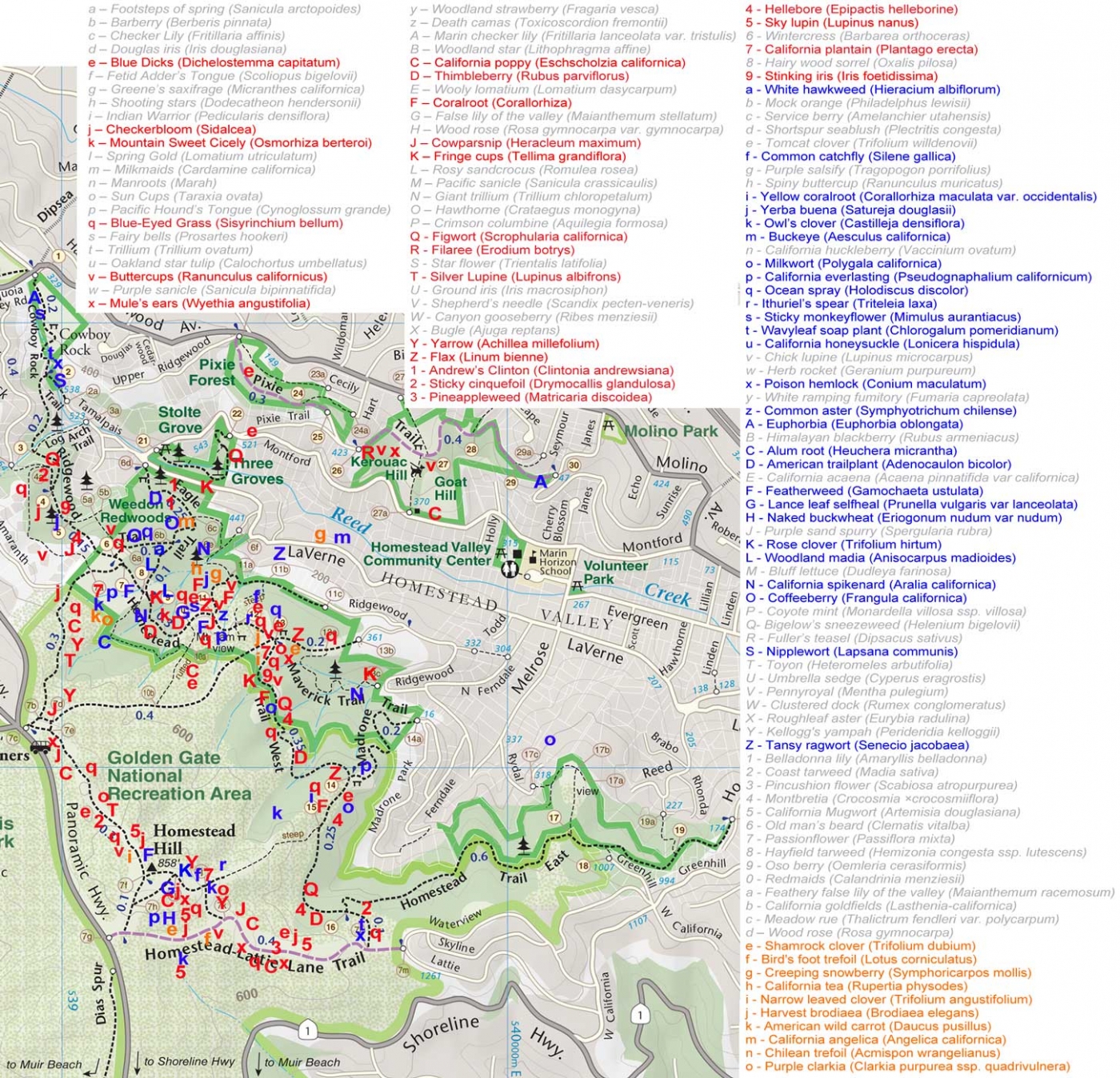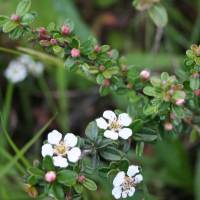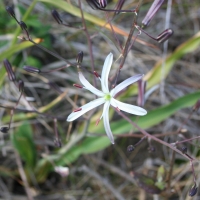NEW
– California spikenard, one of the largest herbaceous plants in North America, grows to 3-9′ each season. Its white firework-shaped flowers are blooming now along creeks in the forests.
– Silverleaf cotoneaster, native to China, a large shrub with white flowers that will become bright red berries is blooming at forest edges.
– Tansy ragwort, native to Eurasia, is blooming with its bright yellow flowers along Laverne. The plant contains alkaloids that catepillars absorb, making them distasteful to predators. As with other alkaloid containing plants like poison hemlock and euphorbia, it can be toxic to people.
– Wavyleaf soap plant, only blooms at dawn and evening. It grows from a bulb covered in thick fibers and the flowers are borne on a tall stalk.
Forests
Starting
– American trailplant, Adenocaulon bicolor, is blooming with small white flowers at the top of a stalk. The bicolor in the Latin name refers to the arrow-shaped leaves that are green on top and whiter underneath. Turn one over to mark your way on the trail.
– California coffee berry is one of our forest shrubs. It has waxy leaves and clusters of small white star flowers.
Peaking
– Cleavers has a very small white flower. The plant creeps and has small cleaving barbs.
– Coralroot is blooming above the trail in the big Indian warrior patch. Look for it in the woods along the Homestead Trail.
– Featherweed is blooming ochre along the forest trails.
– Hedge nettle with its tall stalk and purple flowers is blooming in the forests.
– Hellebore an orchid, is native to Eurasia. The greenish pink flowers climb a 1′ stalk.
– Ocean spray is a forest shrub with soft lobed leaves. The white cone-shaped cluster of frothy flowers are starting to bloom.
– Thimbleberry, in the rose family, with its white flower and lobed leaves, is a forest shrub. The raspberry looking fruit is edible.
– White hawksweed has white feathery flowers and soft leaves. It’s blooming up on the Eagle Trail.
– Woodland madia has bright yellow flowers and is blooming on the Eagle Trail.
– Yellow coralroot, another yellow spike, is blooming at the indian warrior patch, 15.
Fading
– Andrew’s clinton, the most exotic bloom of the redwood understory, has started blooming. Its large waxy leaves and bright pink flower can be seen from the road on the bank above Laverne opposite Stolte Grove.
– California angelica with a large white umbel is blooming beside the Eagle Trail.
– Forget-me-not* the familiar pretty little blue flower, is a European native. This is one of our most successful invasives covering the forest floor and crowding out native species.
– Fringe cups with its greenish fringed flowers is blooming in the forest beside creeks, next to the bridge on the Eagle trail near 9, along the Homestead Trail and on Laverne right after the last house.
Forest Edges
Starting
– California honeysuckle has long pink finger flowers. It is a vine that climbs trees and shrubs to reach sun.
– Common California aster is blooming on the Homestead trail.
– Milkwort has purple winglike flowers on a low plant.
Peaking
– Alum root, with geranium-shaped leaves and a white foamy flower is blooming along the creek near the Meadow rue on the Upper Eagle Trail.
– Buckeye trees are starting to bloom. See them along Laverne.
– Blue eyed grass, not a grass but a member of the iris family, is blooming deep blue/purple up on the ridge and in meadows at the forest edge.
– Cow parsnip, this tall plant with large white umbels is blooming at the forest edge.
– English daisy, a European native, is blooming below Amaranth.
– Figwort, with its small maroon flower is blooming in forest edges. This plant is a favorite of butterflies.
– Hedge parsley, native to Europe, has 3-lobed leaves like a marijuana leaf. Its small white flowers are blooming now. When these fade, there will be small burrs that attach to passerbys and spread this invasive plant along the trails.
– Manroots or wild cucumber is a native vine with white flowers that is blooming all over.
– Nipplewort, native of Europe, is a tall yellow flower along the trail above the Tamalpais Drive steps.
– Sticky cinquefoil looks like strawberry but tall and with a cream flower.
– Yerba buena is a rambling, aromatic mint, delicious and plentiful in Homestead. Its small, white, butterfly-shaped flowers are blooming now.
Fading
– California tea with its tea shaped leaves and purple tipped white pea cluster flowers is blooming beside the trail in the meadow below 11.
– Creeping snowberry with its pretty oval leaves is blooming with tiny pink bell flowers.
– Wood sweet cicely is abundant along all the woodland paths. Its small white blooms are appearing now. Once it goes to seed, the tender pods make a delicious trail snack.
Meadows
Starting
– Bird’s foot trefoil, native of Europe, is a small, yellow pea-shaped flower.
– Buttercup is blooming on the ridge and in some of the lower meadows.
– California everlasting is blooming with its paper-like white blooms up on the ridge.
– California plantain, this tiny plant has needle-like leaves and translucent flowers clustered on a stalk. It’s blooming in a large patch above the junction at 13 and in meadows.
– California poppy is showing its orange bell flower in the meadows.
– Checkerbloom is blooming up on the ridge near the patches of blue dicks.
– Chilean trefoil is blooming bright yellow up on the ridge.
– Common catchfly, native of Eurasia and North Africa, is a windmill white flower on a tall stalk with a striped pod.
– Common vetch, a native of the Mediterranean, is the purple pea blooming in the meadows
– Common Yarrow is a white flowered umbel with feathery leaves. It’s a sun lover and is blooming on the ridge now but will be out it all the meadows soon.
– Euphorbia, native of Eurasia, is blooming in Pixie and Cowboy Rock meadows.
– Flax, native to the Mediterranean region, is a pale blue flower at the end of a long stalk.
– Harvest brodiaea, an elegant blue star flower is blooming now above junction 13.
– Lance leaf selfheal, a velvety tower of purple is blooming along the trail below 7 and near 11.
– Mule’s ear, a yellow sunflower, is blooming in ridge meadows.
– Naked buckwheat is blooming up in ridge meadows now.
– Narrow leaved clover with its pink puff flower blooming beside the Homestead Trail.
– Pineappleweed with its pincushion yellow flowers, smells like chamomile when crushed, is edible and medicinal.
– Poison hemlock, native to Europe, has white umbel flowers. Its stalk is mottled red hinting at the toxicity of this plant.
– Purple clarkia and its purple cone flowers is blooming in the meadow beside the Upper Eagle Trail.
– Purple western morning glory is blooming in meadows up on the ridge and on Kerouac Hill.
– Scarlet pimpernel, native to the Mediterranean basin, is a common little orange splash in the meadow grasses.
– Shamrock clover, native of Europe, has a bright yellow flower and is blooming along trails in meadows.
– Sticky monkeyflower is blooming on Cowboy Rock. This is a sun loving plant that will bloom through the summer.
– Wild radish, native to Asia, is blooming with purple flowers in the meadows on the ridge.
– Wild mustard, a Mediterranean native, is a tall yellow flower in meadows up on the ridge. The flowers are edible.
Peaking
– Ithuriel’s spear, a bright blue funnel is blooming up on the ridge now and will show up in lower meadows soon.
Fading
– American wild carrot with small white umbels and feathery leaves is blooming in the meadow above 8 and below 11.
– Blue dicks, a soft blue cluster at the end of a long stem is bobbing blue on the ridge trail and down in the brighter places along the Homestead Trail.
– Owl clover, not a clover but an Indian paintbrush, is blooming on the knoll below Homestead Hill.
– Rose clover, native to the Mediterranean basin, is blooming up on the ridge.
– Silver lupine, a big bush lupin is starting to bloom up on the ridge.
– Sky lupine, a bright blue and white lupine, grows in single stalks close to the ground.
– White flowered onion*, native to the Mediterranean basin, is blooming in gutters and wet places. All parts of the plant from the bulb to the flower are edible.
Key to map:
I haven’t located plants on on the map if they are very prolific. Find them by their habitat.
Flowers that are not currently blooming have been removed from the map and are greyed out in the map key.

Gallery of wildflowers and plants found in Homestead.
*Non-native
Share this:


